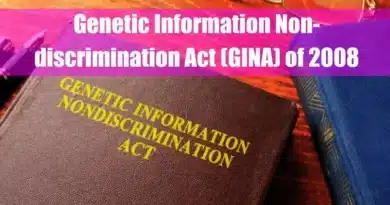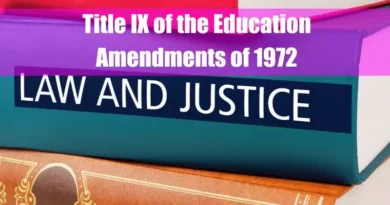Americans with Disabilities Act (ADA) of 1990
Takeaways
| Key Points |
|---|
| The Americans with Disabilities Act (ADA) is a comprehensive law designed to prevent discrimination against individuals with disabilities across various aspects of public life. |
| Title I prohibits employment discrimination by employers with 15 or more employees, requiring reasonable accommodations for qualified individuals with disabilities unless they cause undue hardship; it is enforced by the EEOC and shaped by key legal precedents like Sutton v. United Air Lines. |
| Title II ensures equal access to public services provided by state and local governments, requiring entities to evaluate accessibility, make modifications, and comply with standards enforced by the DOJ, as seen in landmark cases like Olmstead v. L.C.. |
| Title III focuses on public accommodations, mandating that private businesses remove barriers, provide auxiliary aids, and comply with accessibility standards, with enforcement through lawsuits or DOJ actions, impacting businesses of all sizes. |
| Title IV mandates telecommunications companies to provide relay services and closed captioning, overseen by the FCC, with advancements like video relay services enhancing accessibility. |
| Title V addresses miscellaneous provisions, including protections against retaliation, discrimination by association, and the relationship between the ADA and other laws, with amendments like the ADA Amendments Act of 2008 broadening disability definitions to strengthen protections. |
Introduction
Brief Overview of the ADA
The Americans with Disabilities Act (ADA) of 1990 is a landmark civil rights law designed to protect the rights of individuals with disabilities. The ADA prohibits discrimination against people with disabilities in various sectors, including employment, public services, public accommodations, telecommunications, and more.
This law was enacted to ensure that individuals with disabilities have the same rights and opportunities as everyone else.
Historical Context Leading to the ADA
The ADA was born out of a broader civil rights movement that sought to end discrimination against various marginalized groups in the United States. Before the ADA, individuals with disabilities faced significant barriers to employment, education, and access to public spaces.
The movement for disability rights gained momentum in the 1970s and 1980s, with activists and organizations pushing for comprehensive federal legislation to address these issues. Key legislative precedents included the Rehabilitation Act of 1973, particularly Section 504, which prohibited discrimination based on disability in programs receiving federal funding.
The ADA built on these earlier efforts, extending protections to a wider range of public and private entities.
Key Objectives and Principles of the ADA
The primary objective of the ADA is to eliminate discrimination against individuals with disabilities and to provide clear, enforceable standards addressing such discrimination. The law is structured around five titles, each dealing with different aspects of public life. These titles collectively aim to remove barriers and ensure that individuals with disabilities have equal opportunities to participate fully in society.
The ADA emphasizes the importance of accessibility, reasonable accommodations, and the prohibition of discriminatory practices across various domains.

Title I: Employment
Prohibition of Employment Discrimination
Title I of the ADA specifically addresses employment discrimination. It prohibits employers from discriminating against qualified individuals with disabilities in all aspects of employment, including job application procedures, hiring, firing, promotions, compensation, and training. This Title applies to employers with 15 or more employees, employment agencies, labor organizations, and joint labor-management committees.
Definition of Disability under the ADA
The ADA defines a disability as a physical or mental impairment substantially limiting one or more major life activities. This definition also includes individuals who have a record of such an impairment or are regarded as having such an impairment.
The law’s definition of disability is intentionally broad to ensure that it covers a wide range of conditions and that individuals with disabilities are adequately protected under the law.
Reasonable Accommodations: Requirements and Examples
Employers must provide reasonable accommodations to qualified individuals with disabilities unless doing so would cause undue hardship to the business. Reasonable accommodations are modifications or adjustments to the work environment that enable an individual with a disability to perform the job’s essential functions. Examples include providing assistive technology, modifying work schedules, or restructuring job duties.
The goal is to create an inclusive work environment where individuals with disabilities can thrive without facing unnecessary barriers.
Undue Hardship: Definition and Considerations
While employers are obligated to provide reasonable accommodations, they are not required to do so if it would impose an undue hardship on their operations. Undue hardship refers to significant difficulty or expense incurred by the employer when providing an accommodation. Factors such as the business size, financial resources, and the nature of the operation are considered when determining whether an accommodation would result in undue hardship.
Enforcement by the Equal Employment Opportunity Commission (EEOC)
The Equal Employment Opportunity Commission (EEOC) enforces Title I of the ADA. Individuals who believe they have been discriminated against in violation of the ADA can file a complaint with the EEOC. The commission investigates these complaints and may take action against employers found to be violating the law.
The EEOC also guides employers in complying with the ADA and avoiding discriminatory practices.
Case Studies and Key Legal Precedents
Numerous legal cases have shaped the ADA’s interpretation and enforcement of Title I. For example, in the case of Sutton v. United Air Lines, Inc., the Supreme Court ruled that mitigating measures, such as medication or assistive devices, must be considered when determining whether an individual is disabled under the ADA. Another significant case is Toyota Motor Manufacturing, Kentucky, Inc. v. Williams, where the Court clarified the meaning of “substantially limits” in the context of major life activities. These cases and others have played a crucial role in defining the scope of the ADA’s protections in the workplace.

Title II: Public Services
Scope of Title II: State and Local Government Responsibilities
Title II of the ADA covers public services state and local governments provide. It prohibits discrimination based on disability in all services, programs, and activities provided by these entities. This Title ensures that individuals with disabilities have equal access to public services, such as education, transportation, and voting.
Accessibility Requirements for Public Entities
Public entities are required to make their facilities, services, and programs accessible to individuals with disabilities. This includes removing physical barriers in buildings, providing auxiliary aids and services for effective communication, and modifying policies and procedures to accommodate individuals with disabilities.
The goal is to ensure that individuals with disabilities can access and benefit from the same public services as those without disabilities.
Self-Evaluation and Transition Plans
Under Title II, public entities must self-evaluate their current services, policies, and practices to identify any barriers to accessibility. Based on this evaluation, they must develop a transition plan outlining the steps they will take to achieve compliance with the ADA. This process is essential for ensuring that public entities proactively address accessibility issues and work toward full compliance with the law.
Effective Communication and Reasonable Modifications
Public entities must provide effective communication to individuals with disabilities. This may involve providing sign language interpreters, Braille materials, or other auxiliary aids and services to ensure that individuals with disabilities can communicate effectively with government agencies.
Additionally, public entities must make reasonable modifications to their policies, practices, and procedures to avoid discrimination unless doing so would fundamentally alter the nature of the service provided.
Enforcement by the Department of Justice (DOJ)
The Department of Justice (DOJ) is responsible for enforcing Title II of the ADA. The DOJ investigates complaints of discrimination, provides technical assistance to public entities, and may bring legal action against entities that fail to comply with the ADA.
The DOJ also plays a key role in developing regulations and guidelines to help public entities understand their obligations under the ADA.
Landmark Cases under Title II
Several landmark cases have clarified the requirements of Title II. For example, in Olmstead v. L.C., the Supreme Court held that the ADA requires public entities to provide community-based services to individuals with disabilities when appropriate. This decision was a significant step forward in ensuring that individuals with disabilities have the opportunity to live and receive services in the most integrated setting possible.

Title III: Public Accommodations
Definition and Scope of Public Accommodations
Title III of the ADA prohibits discrimination based on disability in public accommodations, including privately owned businesses open to the public, such as hotels, restaurants, theaters, and retail stores. The law requires these businesses to provide equal access to goods and services and to remove architectural and communication barriers that impede access for individuals with disabilities.
Accessibility Standards for New and Existing Facilities
Title III establishes accessibility standards for new construction and alterations to existing facilities. These standards ensure that individuals with disabilities can access and use public accommodations as easily as those without disabilities. For existing facilities, businesses must remove barriers when they are readily achievable, meaning they can be accomplished without much difficulty or expense.
Reasonable Modifications and Effective Communication
Public accommodations must modify their usual practices and procedures to accommodate individuals with disabilities. For example, a restaurant might need to provide a menu in Braille or a hotel may need to allow a service animal in areas where pets are typically not allowed. Additionally, businesses must provide auxiliary aids and services to communicate effectively with individuals with vision, hearing, or speech disabilities.
Enforcement Mechanisms and Penalties
Title III enforcement is primarily carried out through private lawsuits brought by individuals who have been discriminated against. The DOJ may also initiate enforcement actions against businesses that fail to comply with the ADA.
Non-compliance penalties under Title III can include civil penalties and injunctive relief, which mandates that businesses make necessary changes to comply with the law. While financial damages are generally not awarded in federal ADA cases, civil penalties can reach up to $75,000 for the first violation and $150,000 for subsequent violations.
In some state cases, monetary damages may be awarded depending on the specific state laws.
Impact on Businesses and Key Legal Challenges
Title III has significantly impacted businesses, requiring many to make substantial changes to their facilities and practices to comply with the ADA. While these changes have improved accessibility for individuals with disabilities, they have also presented challenges for businesses, particularly small businesses with limited resources. Legal challenges have arisen in cases where businesses argue that certain requirements impose undue burdens or where the definition of “readily achievable” is in dispute.

Title IV: Telecommunications
Telecommunications Relay Services (TRS)
Title IV of the ADA mandates that telecommunications companies provide Telecommunications Relay Services (TRS). These services enable individuals with hearing or speech disabilities to communicate with others over the telephone through a relay operator who converts text to voice and vice versa. TRS ensures that people with disabilities can make and receive phone calls like anyone else.
Closed Captioning Requirements for Public Service Announcements
Under Title IV, the ADA also requires that all federally funded public service announcements be accessible through closed captioning. This ensures that individuals with hearing impairments can fully understand and access important public information broadcast on television or other media platforms.
Role of the Federal Communications Commission (FCC) in Enforcement
The Federal Communications Commission (FCC) is responsible for enforcing the provisions of Title IV. The FCC ensures that telecommunications companies comply with TRS requirements and that public service announcements are properly closed captioned.
The FCC plays a vital role in making telecommunications accessible to individuals with disabilities by setting regulations and handling complaints related to non-compliance.
Technological Innovations and Their Impact on Accessibility
Since the enactment of the ADA, significant technological advancements have further enhanced accessibility in telecommunications. Innovations such as video relay services (VRS), real-time text (RTT), and internet-based communication tools have expanded how individuals with disabilities can communicate.
These developments have profoundly impacted the provision of opportunities for people with disabilities to engage fully in society, particularly in an increasingly digital world.

Title V: Miscellaneous Provisions
Relationship Between the ADA and Other Federal and State Laws
Title V of the ADA contains various provisions, including how the ADA interacts with other federal and state laws. The ADA does not override state laws that provide greater protections for individuals with disabilities. It also clarifies the relationship between the ADA and other civil rights laws, such as the Civil Rights Act of 1964, ensuring that individuals with disabilities are protected under multiple legal frameworks.
Prohibition Against Retaliation and Coercion
One of the key protections under Title V is the prohibition against retaliation and coercion. This provision ensures that individuals who exercise their rights under the ADA or assist others in doing so are protected from retaliation by employers, service providers, or any other entity covered by the ADA.
It is a critical element that safeguards the enforcement of the ADA’s provisions by encouraging individuals to assert their rights without fear of reprisal.
Legal Protections Against Discrimination Based on Association
Title V also includes protections against discrimination based on association. This means that individuals cannot be discriminated against because they are associated with someone who has a disability, such as a family member, friend, or colleague. This provision recognizes that discrimination can occur not only directly but also through relationships with individuals with disabilities.
Overview of ADA Amendments and Their Impact
Since its original enactment, the ADA has been amended to address evolving understandings of disability and to strengthen its protections. For example, the ADA Amendments Act of 2008 broadened the definition of disability and clarified that it should be interpreted in favor of broad coverage.
These amendments have significantly affected the ability to ensure that the ADA remains an effective tool for protecting the rights of individuals with disabilities.
Enforcement and Legal Remedies
Overview of Federal Agencies Involved in ADA Enforcement
Several federal agencies are responsible for enforcing the ADA, depending on the specific Title and area of public life. For example, the EEOC enforces Title I for employment, while the DOJ enforces Title II and III for public services and public accommodations. The FCC oversees compliance with Title IV related to telecommunications. Each agency provides guidance, handles complaints, and, when necessary, takes legal action against entities that violate the ADA.
Procedures for Filing Complaints and Lawsuits
Individuals who believe their rights under the ADA have been violated can file complaints with the relevant federal agency. If the issue is not resolved through administrative processes, they may file lawsuits in Federal Court.
The ADA provides for various remedies, including injunctions to stop discriminatory practices, compensatory damages, and sometimes punitive damages. These legal mechanisms are essential for enforcing the rights guaranteed by the ADA.
Remedies Available to Victims of Discrimination
Victims of discrimination under the ADA can seek various remedies, depending on the nature of the violation. These may include reinstatement to a job, back pay, compensation for emotional distress, and reasonable accommodations that were previously denied. In cases of willful violations, courts may also award punitive damages to deter future violations.
Overview of Significant ADA-Related Court Cases
Over the years, numerous court cases have shaped the interpretation and enforcement of the ADA. These cases have addressed the definition of disability, the scope of reasonable accommodations, and the balance between accessibility and undue hardship. Significant cases like those mentioned earlier (e.g., Sutton v. United Air Lines, Inc. and Olmstead v. L.C.) continue to influence how the ADA is applied and understood in various contexts.
Impact of the ADA: A Retrospective Analysis
Changes in Employment and Public Access since 1990
The ADA has significantly changed how employment and public access are managed in the United States. In workplaces, the ADA has mandated that employers make reasonable accommodations, such as accessible workspaces, flexible work schedules, and assistive technologies, to ensure that individuals with disabilities can fully participate.
This requirement has encouraged businesses to create more inclusive environments.
Substantial improvements in accessibility have been made in public spaces. Many government buildings, schools, and transportation systems have become more accessible by removing architectural barriers. Features like ramps, elevators, and Braille signage have become standard, making it easier for individuals with disabilities to engage in daily activities.
Success Stories and Remaining Challenges
The ADA has led to many success stories, enhancing the lives of individuals with disabilities by providing greater independence and societal inclusion. Access to public transportation has improved for people with mobility impairments, and workplaces have become more accommodating.
These successes illustrate the ADA’s role in improving quality of life and promoting equality.
However, challenges persist. Some individuals with disabilities still face obstacles, particularly in digital accessibility and consistent law enforcement. The rapid pace of technological advancement has introduced new barriers, and there are ongoing debates about how best to address these issues.
The Role of Advocacy Groups in Promoting ADA Compliance
Advocacy groups have been crucial in promoting ADA compliance and raising awareness. Organizations like the National Council on Disability (NCD) and the American Association of People with Disabilities (AAPD) provide resources and support to individuals with disabilities and help ensure that entities comply with the ADA. These groups continue to push for stronger enforcement and necessary updates to the law.
Recent Developments and Future Directions
The ADA Amendments Act of 2008: Key Changes
The ADA Amendments Act of 2008 (ADAAA) was a key development in disability rights law. It broadened the definition of disability, making it easier for individuals to qualify for ADA protection. The ADAAA emphasized that the definition of disability should be interpreted broadly, ensuring that more people are covered under the law. This amendment has led to a broader application of the ADA and increased enforcement.
Emerging Issues in ADA Enforcement
New challenges have emerged in ADA enforcement, particularly regarding digital accessibility. As reliance on the internet and digital platforms grows, there is increasing concern that many websites and apps are not accessible to individuals with disabilities.
Although progress has been made, clearer regulations and more consistent enforcement are needed to ensure digital spaces are as accessible as physical ones.
Another emerging issue is the intersection of disability rights with other civil rights areas, such as LGBTQ+ rights and racial justice. As the understanding of intersectionality grows, the ADA must adapt to address the unique challenges faced by individuals who belong to multiple marginalized groups.

Technological Advancements and Accessibility
Technological advancements have had a mixed impact on accessibility. On the one hand, innovations like screen readers, voice recognition software, and advanced prosthetics have greatly enhanced the capabilities of individuals with disabilities, allowing them to participate more fully in society. On the other hand, the rapid pace of technological change has introduced new barriers, such as complex user interfaces and inaccessible mobile apps, which can exclude individuals with disabilities from digital participation.
Predictions for the Future of Disability Rights
The ADA will likely continue to evolve to address new challenges in disability rights. Key focus areas will be strengthening digital accessibility, expanding protections for marginalized groups, and ensuring that new technologies are inclusive.
Ongoing advocacy and legislative updates will be essential to maintain and advance progress since the ADA’s enactment.
Conclusion
The Americans with Disabilities Act of 1990 remains vital to civil rights legislation. It has greatly improved the lives of individuals with disabilities by promoting equal opportunities and removing barriers.
Despite ongoing challenges, the ADA has set a strong foundation for future progress.
As society changes, the ADA must adapt to ensure its protections remain effective and relevant, fulfilling its promise of equal rights for all.
FAQ
What is the Americans with Disabilities Act (ADA) of 1990?
The ADA is a civil rights law enacted in 1990 that prohibits discrimination against individuals with disabilities in all areas of public life, including jobs, schools, transportation, and public and private places open to the general public.
Who is protected under the ADA?
The ADA protects individuals with physical or mental impairments that substantially limit one or more major life activities, those with a history of such impairments, and individuals perceived by others as having such impairments.
What are the main titles of the ADA?
The Americans with Disabilities Act (ADA) is structured into five distinct titles, each addressing specific areas to prevent discrimination against individuals with disabilities:
- Title I: Employment – This title prohibits employers with 15 or more employees from discriminating against qualified individuals with disabilities in all aspects of employment, including hiring, promotion, and termination.
- Title II: Public Services (State and Local Government) – Title II mandates that state and local governments provide individuals with disabilities equal access to their services, programs, and activities, ensuring inclusivity in all public offerings.
- Title III: Public Accommodations and Services Operated by Private Entities – This title requires private entities that offer public accommodations—such as hotels, restaurants, and theaters—to eliminate barriers and ensure accessibility for individuals with disabilities.
- Title IV: Telecommunications – Title IV obligates telecommunications companies to provide functionally equivalent services to individuals with disabilities, including relay services for those with hearing or speech impairments.
- Title V: Miscellaneous Provisions – This title contains various provisions, including guidelines on the ADA’s relationship to other laws, state immunity, and its impact on insurance providers and benefits.
Each title plays a crucial role in ensuring comprehensive protection and equal opportunities for individuals with disabilities across different sectors of society.
How does Title I of the ADA affect employment?
Title I prohibits employers with 15 or more employees from discriminating against qualified individuals with disabilities in job application procedures, hiring, advancement, termination, compensation, job training, and other terms of employment.
What constitutes a reasonable accommodation in the workplace?
A reasonable accommodation is any modification or adjustment to a job or work environment that enables a qualified individual with a disability to perform essential job functions. Examples include making existing facilities accessible, job restructuring, modifying work schedules, and acquiring or modifying equipment.
Are all employers required to comply with the ADA?
Employers with 15 or more employees are required to comply with Title I of the ADA. However, smaller employers are encouraged to provide accommodations and avoid discrimination, even if not legally mandated.
How does the ADA impact public transportation?
Title II of the ADA requires public transportation agencies to make their services accessible to individuals with disabilities. This includes providing accessible buses and rail vehicles, paratransit services, and ensuring that new facilities are designed to be accessible.
What are public accommodations under the ADA?
Public accommodations are private entities that own, operate, or lease places open to the public, such as restaurants, hotels, theaters, retail stores, and doctors’ offices. Title III of the ADA prohibits discrimination in these places and requires them to be accessible to individuals with disabilities.
Are websites required to be ADA-compliant?
While the ADA does not explicitly mention websites, courts and the Department of Justice have interpreted the law to require that businesses’ websites considered public accommodations be accessible to individuals with disabilities. This includes providing features like text alternatives for images and ensuring compatibility with screen readers.
What is the role of service animals under the ADA?
The ADA allows individuals with disabilities to bring service animals into all areas where the public is permitted. A service animal is defined as a dog that is individually trained to do work or perform tasks for a person with a disability.
How does the ADA address communication barriers?
The ADA requires public accommodations to provide auxiliary aids and services to communicate effectively with individuals with disabilities. This can include providing qualified interpreters, written materials, or assistive listening devices, depending on the needs of the individual.
Are private clubs and religious organizations subject to the ADA?
Private clubs and religious organizations are generally exempt from ADA requirements. However, if these entities engage in activities that are open to the public, they may be subject to ADA provisions during those times.
What is the ADA’s stance on historic properties?
The ADA requires that alterations to historic properties comply with accessibility standards to the maximum extent feasible. If full compliance threatens or destroys a feature’s historical significance, alternative access methods may be used.
How does the ADA affect telecommunications?
Title IV of the ADA mandates that telephone companies provide relay services for individuals who use telecommunications devices for the deaf (TDDs) or similar devices, ensuring effective communication over the phone.
What enforcement mechanisms exist under the ADA?
Individuals who believe they have been discriminated against under the ADA can file complaints with federal agencies, such as the Equal Employment Opportunity Commission (EEOC) for employment-related issues or the Department of Justice for public accommodations. Legal action in federal court is also an option.
Are there tax incentives for businesses to comply with the ADA?
Yes, the IRS offers tax incentives to encourage businesses to comply with the ADA. The Disabled Access Credit provides a non-refundable credit for small businesses that incur expenses for providing access to persons with disabilities. Additionally, the Architectural Barrier Removal Tax Deduction allows businesses to deduct expenses incurred to remove physical, structural, and transportation barriers.
How does the ADA define a disability?
Under the ADA, a disability is a physical or mental impairment substantially limiting one or more major life activities. This includes conditions affecting mobility, hearing, vision, and cognitive functions, among others.
Can an employer ask about my disability during a job interview?
No, employers are prohibited from asking about the existence, nature, or severity of a disability during the hiring process. They may inquire about your ability to perform specific job functions and can ask you to describe or demonstrate how you would perform these functions, with or without reasonable accommodation.
Citation
Americans with Disabilities Act of 1990, As Amended. (n.d.). ADA.gov. https://www.ada.gov/law-and-regs/ada/









